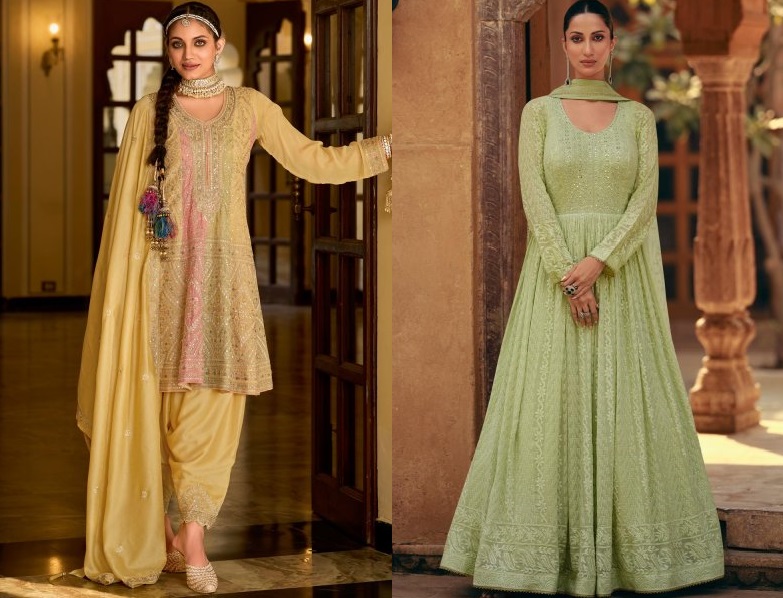Indian women’s clothing is a colourful representation of the nation’s rich cultural legacy, which is intricately linked to its history and geographical variety. These clothes have deep cultural, social, and symbolic connotations that have developed over millennia; they are more than just articles of clothing. One will find a wide range of Indian designer dresses, ranging from sarees, lehengas, salwar kameez to Indo western outfits. Because of its versatility and sustainability, the Indian outfit is gaining popularity all across the world. The article delves into the cultural and historical significance of Indian outfits.
Historical significance
Early evidence of weaving and dyeing has been found dating back to the Indus Valley Civilisation (c. 3300–1300 BCE), which is when India’s textile and garment history began. Ancient literature such as the Vedas and the Mahabharata make reference to a variety of clothes, implying that clothes have always played a major role in Indian culture. Indian textiles rose to prominence under the Mauryan (322–185 BCE) and Gupta (320–550 CE) dynasties for their superior quality and beauty. The main textiles were cotton and silk, and natural dyes and elaborate weaving techniques were highly prized. The Mughal period (1526–1857) brought expensive textiles like brocade, intricate needlework, and the skill of Mughal miniature painting—which frequently featured the extravagant clothing of women—to Indian design, further enhancing it with Persian influences.
The significance of culture
The most recognisable Indian women’s dress is probably the saree, a classic piece of clothing. This unstitched cloth is delicately draped in a variety of ways around the body. Its length typically ranges from five to nine yards. The saree is a representation of grace and femininity rather than just a style of apparel. The Rig Veda contains references to its ancient roots. Over time, the saree has changed to reflect local aesthetics and weaving styles, like Varanasi’s Banarasi silk and Tamil Nadu’s Kanjeevaram silk. Today, one will find modern and contemporary sarees under the category of Indo western fusion wear as well.
The Mughal era gave rise to the salwar kameez, which is a combination of a tunic (kameez) and trousers (salwar), frequently accessorised with a dupatta (scarf). It is especially well-liked in Punjab and North India. This costume is comfortable and versatile enough to wear every day, but its intricately embroidered variations are better reserved for special events. The fusion of Indian sensibilities with Central Asian influences is seen in the salwar kameez.
Most people identify the lehenga choli, a traditional dress that consists of a long skirt called a lehenga and a top called a choli, at festivals and weddings. Its origins can be found in the Mughal era, when regal women wore it. The lehenga choli is a sign of joy and celebration since it is frequently beautifully adorned with embroidery, mirror work, and intricate beads.
Significance and social symbolism
Indian women’s clothing has societal and symbolic significance in addition to being a matter of personal taste. For example, colours are important. Brides traditionally wear red, which is linked to fertility and prosperity. On the other hand, wearing white during mourning represents resignation and purity. Regional identity and social standing are often reflected in traditional clothing. One’s socioeconomic status or place of origin might be inferred from the type of fabric, the intricate embroidery, and the manner of draping or sewing. For instance, the Gujarati Patola saree, renowned for its double ikat weaving method, was once considered a prestige and money symbol.
Current Significance
Indian women’s clothing has evolved with the times to reflect shifting global fashion tastes and lifestyle changes while maintaining its inherent cultural characteristics. Younger generations now find traditional clothing appealing thanks to the revitalisation of these styles by designers such as Anita Dongre and Sabyasachi Mukherjee. The combination of modern and traditional designs has produced a vibrant fashion scene that honours history while welcoming innovation.
Summing up
Indian women’s clothing celebrates the diversity of the nation’s cultures. They are much more than just clothes; they are symbols of societal ideals, historical histories, and local identities. India’s traditional clothing, which reflects the ageless beauty and richness of Indian heritage, is still a vital and essential element of the country’s cultural identity even as it changes. Therefore, many people across the world love and adore traditional Indian outfits and modern Indian fusion wear.
